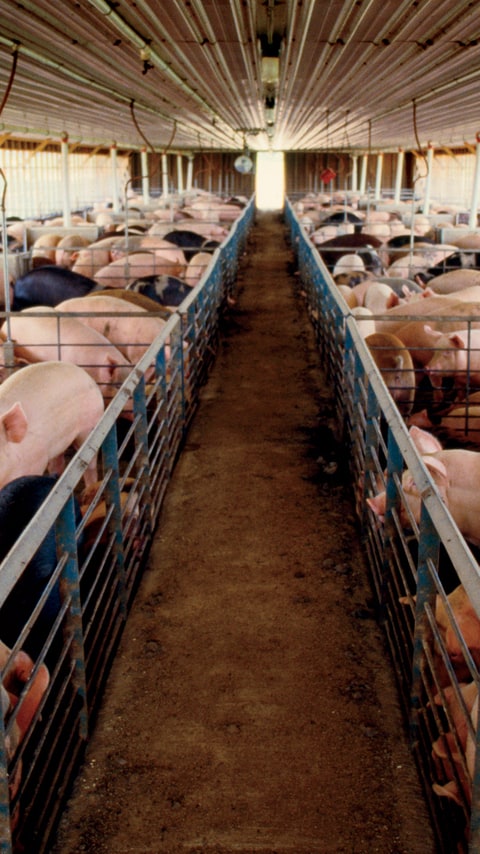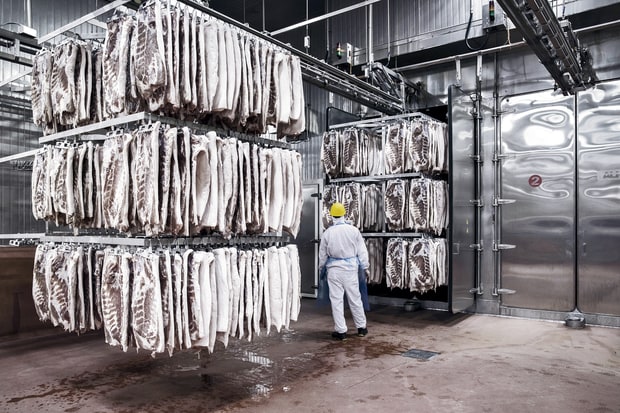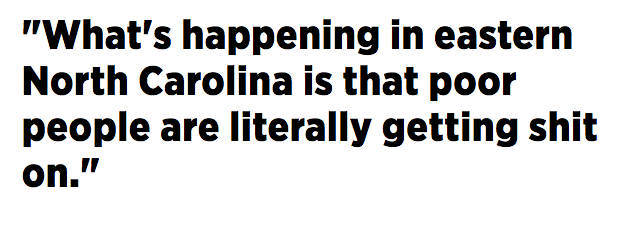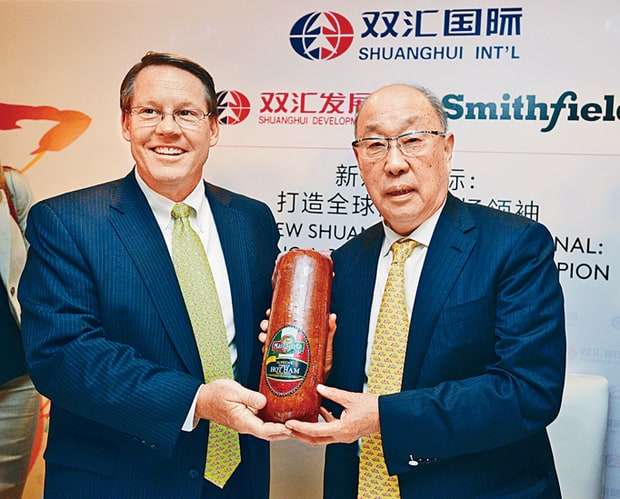Rolling Stone: Why Is China Treating North Carolina Like the Developing World?

Duplin’s hogs generate 15,700 tons of waste a day – about twice the amount as the entire population of New York City. Grant Heilman Photography/Alamy
By Doug Bock Clark | March 19, 2018
How lax regulation made it cheaper for China to outsource pork production – and all of its environmental and human costs – to the U.S.
In July 2013, Larry Pope, the CEO of Smithfield Foods, the largest pork producer in America, was called to testify before a U.S. Senate committee about the pending sale of his company to a Chinese conglomerate now known as WH Group. The $7.1 billion purchase, the largest-ever foreign takeover of its kind, had attracted concerns. The Chinese pork manufacturer had a checkered health record, allegedly feeding its hogs illegal chemicals, and Smithfield had a long history of environmental problems at its farms, including a $12 million fine for several thousand clean-water violations. But the worries did not stop there. The Chinese government had a track record of using nominally private entities as proxies for state power. “To have a Chinese food company controlling a major U.S. meat supplier, without shareholder accountability, is a bit concerning,” said Republican Sen. Chuck Grassley. “A safe and sustainable food supply is critical to national security. How might this deal impact our national security?”
In a measured Southern drawl, Pope explained that the deal was a win for everyone. Pork markets were declining in America, while China had become the largest pork consumer in the world. The takeover would create jobs in rural America by opening a vast market. When senators pressed Pope about whether the takeover was being directed by the Chinese government, the executive laughed it off. He promised both companies would respect the health of the communities and the environment surrounding hog farms. A few months later, the deal was approved.
Questions soon emerged about the transaction. China’s national economy is directed by Five-Year Plans, economic blueprints handed down by the government that private companies are expected to follow. In 2011, as the nation’s billion-plus citizens continued to forge a stable middle class of pork consumers, the government issued a plan directing Chinese companies to buy foreign food producers and farmland. In two years, Chinese nationals went from owning $81 million worth of American farmland to nearly $1.4 billion, including the Smithfield purchase. Despite Pope’s denials of Chinese-government involvement, the nation’s central bank had approved a $4 billion cash loan to fund the acquisition, a transaction its 2013 annual report described as a “social responsibility.” The investigative news organization Reveal uncovered documents showing that WH Group receives guidance from the government, which a company executive explained was because “pork is considered a national-security issue in China.” When a reporter from Reveal confronted Pope with the financial documents showing the Chinese government’s support for the deal, the first thing he said was “Wow.” (Keira Lombardo, Smithfield’s senior vice president of public affairs, contested the characterization that the Chinese government directed the purchase.)
Today, Smithfield sends more than a quarter of its pork abroad, especially to China, which received nearly 300,000 tons in 2016. Part of what made the company such an attractive target is that it’s about 50 percent cheaper to raise hogs in North Carolina than in China. This is due to less-expensive pig-feed prices and larger farms, but it’s also because of loose business and environmental regulations, especially in red states, which have made the U.S. an increasingly attractive place for foreign companies to offshore costly and harmful business practices.
America’s top hog-producing county is Duplin County, North Carolina, where future hams outnumber humans about 30 to 1. In this rural expanse of sandy fields and loblolly pines, about 2 million pigs are warehoused in hundreds of football-field-size metal barns – about 2,450 pigs per square mile. All those pigs produce a tremendous amount of waste. A mature hog, whose only activity is to eat, excretes about 14 pounds of manure a day, which means Duplin’s hogs generate about 15,700 tons of waste daily – twice as much poop as the human population of the city of New York, according to Food and Water Watch.

Some 9 million hogs are warehoused in Eastern North Carolina; the 15.5 million tons of waste they produce each year are typically kept in unlined open-air lagoons Travis Dove
Behind each barn, millions of gallons of liquid hog waste are kept in colossal open-air lagoons – essentially pits dug into the clay, many without a concrete or plastic liner. To prevent overflowing, farms spray it out as fertilizer on crops, which can create a mist that drifts onto nearby homes and into their inhabitants’ lungs, causing all manner of respiratory and health problems. The waste can also leak through the clay pits into the water table, or flood the whole region, as happened in 1996 and 1998 when hurricanes inundated the area. Eastern North Carolina is packed with more than 9 million pigs; the state’s top five hog-producing counties alone produce 15.5 million tons of manure annually. An analysis by the Environmental Working Group found that 160,000 people living in the region may be harmed by pig waste. And those victims are disproportionately minorities, according to studies conducted by the University of North Carolina-Chapel Hill. As Naeema Muhammad, co-director of the North Carolina Environmental Justice Network, says, “What’s happening in eastern North Carolina is that poor people are literally getting shit on.”
Globalization has allowed rich countries like America to outsource polluting industrial processes to poorer nations. But as China becomes increasingly wealthy and assertive, says Democratic Sen. Cory Booker, “it is outsourcing a dirty industry to the United States so they don’t have to bear its pollution and they can just send the finished product back home.” More than just America’s environment and human health is at stake. “Low-paying jobs, like hog slaughtering and breeding, will remain in places like Duplin County, but the higher-paid executive and marketing jobs will be lost,” says Usha Haley, a professor at West Virginia University who has studied the Chinese takeover of American agricultural assets for a decade. “China will not care about the health of people living beside the hog farms. China will act in its own self-interest to leave the pollution here, but take the valuable clean pork back to China.”
As jobs and talent have flocked to American cities, once-prosperous rural communities are finding their primary competitive advantages are desperate residents willing to work cheap, and local Republicans ready to extend tax breaks and slash regulation. American companies have long taken advantage of these trends. A leaked report from the 1980s, which was prepared for a waste-management company seeking a community for “locally undesirable land use,” listed the “least resistant personality profile” as: “longtime residents of small towns in the South or Midwest,” “conservative,” “Republican” and “advocates of the free market.”
In recent years, foreign conglomerates have seized upon this workforce as well. In 2011, the last time the United States Department of Agriculture released figures, overseas entities owned agricultural acreage roughly the size of Virginia, holdings that have only continued to grow. Investors from Saudi Arabia and the United Arab Emirates have since purchased 15,000 acres of the parched Southwest to grow water-intensive crops, such as alfalfa hay for their dairy herds back home. In the case of Smithfield Foods, WH Group inherited a practice in which local farmers are encouraged to build facilities on credit for raising pigs set for slaughter. As a result, the company now owns the hogs, the most lucrative part of the business, while the North Carolina farmers own the shit – and all the environmental and human liabilities from it. As Jason Gray, a senior researcher at the economic-policy organization NC Rural Center explains, “The dilemma rural economies face is that you’ll reach for anything if you have nothing.”
“We can only stay a few minutes,” René Miller says, as we park at her family graveyard. Miller grew up on a neighboring farm about half a mile away, on land that had belonged to her family since the Civil War. But when her mother went to get loans to modernize their farm, Miller says, she was turned down by banks and the USDA. Such stories of discrimination are common among African-American farmers in North Carolina. The family that owned the land where Miller’s kin now lie took out a loan from someone advertising on TV as “Mr. Cash.” After the property went into foreclosure, the acres the family owned for more than a century were bought by a white farmer. In 1999, the USDA settled a billion-dollar class-action lawsuit initiated by a North Carolina farmer, admitting African-Americans had been denied loans because of their race. Now, Miller is only allowed on the property to visit her dead.
Opening the van door, the stench – animal and fecal – wets the air like humidity. The source is a few hundred feet away: six airplane-hangar-like metal barns, warehousing around 4,300 hogs, backed by three acres of liquid pig waste in an open-air lagoon. Miller brushes fallen pine needles off the headstones of her grandmother and her mother, before reaching that of her nephew, who recently died of cancer. As she kneels next to the stone, she tells me, “I think it killed him.”
She means the hog waste. Specifically, the approximately 30 tons of manure the swine in the barns excrete daily through slatted floors into the lagoon, which is then pumped through an industrial sprayer to fertilize crops. These clouds of aerosolized feces, Miller says, drift over a country road and coat her home, where her nephew once lived. Both times I visited, the sprayers in the field across the road were off, but the reek was noticeable inside the house, despite the cardboard barriers Miller had improvised to seal her windows.
The industry describes hog waste as “organic fertilizer,” though in reality it is potentially lethal. To keep swine alive in overcrowded hothouses, where diseases spread rapidly, pigs are treated with antibiotics, vaccines and insecticides, all of which eventually pass into the lagoons, which have been found to contain toxic chemicals, nitrates, parasites, viruses and more than a hundred strands of antibiotic-resistant microbes, including salmonella, streptococci and giardia. People die with distressing regularity in the waste: In 2015, an Iowa teenager overcome by methane, ammonia and carbon dioxide fumes fell into the sludge. When his father tried to haul him out, they both drowned in excrement.
In 2008, a Government Accountability Office survey found 15 studies that linked animal waste from industrial livestock farms with widespread health problems. Living near hog farms increases people’s risk for respiratory problems, diarrhea, eye irritation, depression, high blood pressure, miscarriages, and impaired thinking and breathing; Miller blames the pig waste for her asthma, sarcoidosis and heart ailments. Livestock farmers themselves have been found to be more likely to suffer from respiratory illnesses like chronic bronchitis and antibiotic-resistant staph infections.
Even people who live much farther away from hog farms can suffer from the fallout. A North Carolina Department of Health and Human Services study found that students in middle schools up to three miles away had higher rates of asthma. Just being able to smell the stink has been correlated with increased tension, anger, depression, fatigue and confusion. Leaks through the clay bottoms of lagoons can spread E. coli into groundwater and nearby wells. Hog waste has not been proved to correlate with cancer, but researchers at Duke University are currently conducting a wide-ranging study into possible links. Shane Rogers, a professor at Clarkson University and former Environmental Protection Agency engineer, has studied the issue extensively. “A wide body of research,” he says, “shows that living near pig farms can be hazardous to people’s health.”
As INDY Week reported last year, such hazards have led to 26 lawsuits with nearly 500 complainants, including Miller, against a subsidiary of Smithfield, arguing that the company is failing to take the necessary steps to protect them. Most of the complainants are people of color. A 2014 University of North Carolina study found that African-Americans and other minorities are 1.5 times more likely than white people to live near an industrial hog operation. All 20 or so people dwelling on the lonely stretch of country road around Miller are African-American or Hispanic. Meanwhile, the white owner of the farm, Miller says, lives far away. “This spatial pattern is generally recognized as environmental racism,” the 2014 study concluded.
Smithfield has portrayed the lawsuit as part of a “money grab” led by lawyers and anti-corporate activists. When I visit the farm with Don Butler, then-director of public affairs for one of Smithfield’s primary subsidiaries, he dismisses most odor concerns and casts doubt on the scientific community’s judgment that living near hog farms can harm people. His company, he says, had received no complaints from Miller’s neighbors. However, when I interview five of the households living near Miller, they all report similar respiratory problems and complain about the stink from the farm – none of them have filed reports with Butler’s office because they have not known how to do so and do not believe the company would help them if they did. Ruth Boykin Webb, the widow of Miller’s deceased nephew – whose house Butler pointed to when he claimed the company had received no other complaints – tells me, “I want to move, but I don’t have the money. The hog farmer needs to come in a camper and stay here with us. He don’t live near a hog farm.” (Butler says his company can “only fix problems we are aware of.”)
The problem of pig waste in Duplin County has become a national cause. The EPA’s civil-rights office has sent a stern “letter of concern” to North Carolina, and a bill introduced in Congress to rein in the current hog-waste-management system is languishing in committee. Booker has twice visited the area to highlight how industrial pollution disproportionately affects minority communities. “People don’t know that a Chinese company is poisoning American land, water and people, all to export pork products outside this country,” he tells me. “I was astonished. I really was angered, and could not believe this is how we’re dealing with this amount of feces.”
On a crisp fall day last year, Mike Aldridge, Duplin’s county manager, squires me around his neat 5,800-hog operation with courtesy and evident pride. He’d grown up raising mostly tobacco on a small farm and had wanted to continue working the land as his parents had. But in the late 1980s, Duplin was buffeted by the collapse of tobacco prices and the farm crisis, in which many family farms, undone by debt taken on to compete with corporate giants, were going under. Hog farming let Aldridge make enough money from his land that he didn’t have to sell it. As he leads me around hay fields, far enough from his waste lagoons that the stink is just detectable on the breeze, he tells me, “Hog farming’s been good for a lot of folks and the economy in Duplin County. It’s kept a lot of people on the farm that otherwise wouldn’t have had the opportunity to stay there.” In fact, he says, Duplin’s hog farmers have a saying about the region’s signature stink: To them, it’s the “smell of money.”
Later that day, Aldridge takes me on a walking tour of Duplin’s county seat, Kenansville, population 855, a red-brick town that looks like a time capsule of the 1950s. In between greeting passersby by name, Aldridge points out the agricultural supply store, barber and other businesses that have been around for decades, explaining how hog farming has helped Duplin weather the exodus of jobs and youth that has ravaged vast swaths of rural America. The next day, driving through parts of rural eastern North Carolina less supported by hog farming, I witness the alternative: mostly boarded-up main streets. Kelly Zering, a professor at North Carolina State University who studies the hog industry, tells me that hog-farming communities “have been considerably more resilient and prosperous than similar rural areas in North Carolina that have no pork or poultry development.” Gray, the Rural Center researcher, says, “I wouldn’t want to live next to a hog farm, but whether you like it or not, it’s pretty clear it’s an economic asset for the county.”
But hog farming didn’t so much save Duplin’s family farms as transform them into something nearly unrecognizable. In the 1970s, Wendell Murphy, a Duplin hog farmer, seized on technical advances that made it possible for one man to care for thousands of pigs with mechanized feeding systems. His company, Murphy-Brown – the Smithfield subsidiary that is currently the defendant in Miller’s lawsuit – convinced farmers to borrow huge sums to build facilities to raise hogs that it would then slaughter. This would become known as “contract farming,” as farmers only owned their land, barns and feeding equipment, and the pork industry owned the animals themselves. Decades before Uber, American hog farming was a forerunner of the gig economy.
Profits boomed and the number of pigs in North Carolina quadrupled to 10 million in a little more than two decades. Murphy used his fortune to get elected to the state Legislature, where he backed laws that fueled the industry’s expansion. One bill he co-sponsored treated 10,000-head industrial operations as small family farms to exempt them from zoning regulations, and an amendment he sponsored gutted penalties for illegally discharging hog waste into streams. Two other laws he supported made building materials for hog farms tax-exempt. And though Murphy has now retired, Jimmy Dixon, a representative for a nearby hog-farming county who has received more than $100,000 in contributions from the pork industry, introduced a bill last year that would effectively neuter Miller’s lawsuit against Murphy-Brown. When the Democratic governor vetoed it, the Republican-controlled state Legislature overruled him and passed a slightly watered-down version of the original law.
Today, hog farming in the state is a $2.9 billion industry, responsible for 46,000 jobs, according to the North Carolina Pork Council, which likes to portray the industry as a network of family-owned businesses forming the economic backbone of the eastern sand hills. But such a picture is incomplete. The area’s hog farms got bigger by gobbling up smaller family farms – in 1986, there were 15,000 hog farms in North Carolina; today, only around 2,300 remain. Most people involved in the industry would only speak about the issue anonymously, as contracts allow Smithfield to cut farmers loose with little provocation. But hog farmers have long complained that companies are not paying enough. Many of them, including Aldridge, hold second jobs because contracts do not include benefits or provide a full-time income, despite the long hours the work demands. Tom Butler, a contract farmer for one of Smithfield’s competitors, says, “The companies preyed on the American dream of owning your own business, so we took on a lot of debt. But they pay you just enough to make payments, but never enough to get out of debt.”
The overall economic benefits of hog farming have actually been relatively small. According to an analysis provided by the Rural Center, Duplin County fared well compared to other rural North Carolina counties over the past decade, losing slightly less population and suffering an average employment loss of only three percent compared to six percent statewide. But Duplin County is still impoverished. More than 21 percent of residents live below the poverty line, about twice the national average. And what economic benefits remain are largely enjoyed by white farmers – in 2012, the USDA census recorded 269 hog farms operated by white farmers in Duplin County, compared to only 16 operated by African-Americans. Aldridge admits “white families almost certainly had the opportunity to profit from hog farming because they were wealthier, whereas African-American families did not.”
Smithfield’s Don Butler says that “this model has worked well for thousands of farmers for years.” And Murphy-Brown is the largest employer in Duplin County. Hog-farming advocates also argue that the industry has strengthened its regulatory practices since high-profile lapses with lagoons in the late 1990s, such as widespread hurricane-induced flooding and leaks into rivers, which in one case reportedly killed 10 million fish. A hurricane in 2016 led to comparatively little spillage. The Pork Council notes, “Hog farming is among the most highly regulated industries in North Carolina agriculture.”
What matters most to Aldridge is that he is still a farmer. He is adamant that his farm does not harm anyone beyond an occasional bad smell and dismisses research showing otherwise as biased by academia’s liberalism. “I take pride in making a living off my family’s land,” he tells me as we look out over his eight massive metal barns and the adjacent waste lagoon. “Just as my father and grandfather did.”

Rene Miller, who has lived in Duplin County all of her life, is suing a Smithfield subsidiary. A street sign near her home bears the name of her mother. Alex Boerner
Tom Butler grew up on the same kind of small eastern North Carolina farm as Aldridge and Miller, raising tobacco and a few hogs, which his family would butcher and smoke every fall at community gatherings. When the contract-farming boom arrived, he and his brother took on nearly $1 million in debt to build a larger operation. But one night his brother’s wife’s sister, who lived nearby, called and said, “You know, I can smell the shit in my house.” Butler decided, “We don’t have any right to make others suffer for us growing hogs if we can do better,” and has since become a thorn in the side of the hog industry, experimenting with and promoting clean technology. “The world has to be fed, but we can do food without the odor.”
When I drive up the dirt road to Butler’s farm, I pass signs announcing the environmental and business awards he has won. He walks me out onto a green plastic tarp covering a waste lagoon. The poop sloshes beneath our feet, but I can barely smell it. The tarp is part of a biogas digester, with pipes funneling methane to an engine, which then converts the gas to electricity that Butler sells to power companies. The investment in biogas digesters, he tells me, could lead to a cleaner and more profitable form of hog farming. Gray, at the Rural Center, advocates for such a “diversified economy,” a mix of traditional agriculture and high-tech innovation, as one way that rural areas might stop their decline.
In 2000, Smithfield supported a $17 million initiative to research more environmentally friendly ways of managing hog waste, but the cheapest option would have cost an additional $52,000 per farm. Instead, the company continued to develop its lagoon system, which Smithfield’s former chief sustainability officer has defended as “state of the art.” Critics charge that biogas digesters have since become more economical and that Smithfield could trim some profit off its $15 billion in annual sales to become a better corporate citizen.
The technology is not proving too expensive for Smithfield to use elsewhere: On its farms in Utah, the company uses anaerobic digesters similar to Butler’s. WH Group uses two biogas digesters at its Chinese farms, as well as a more-advanced dry-manure process instead of open-air lagoons. And China’s ministry of agriculture has promoted the use of biogas digesters. When I ask Don Butler, Smithfield’s former director of corporate communications, why the methods used by WH Group in China could not be employed elsewhere, he tells me that “lagoons work better for North Carolina’s warm climate. . . I’ve seen growers go bankrupt trying to use alternative systems.” Smithfield, after all, has a responsibility to its shareholders. That’s the American way.
American economic philosophy has long centered on the idea that deregulation is good for businesses, whose growth will provide jobs and prosperity, which will make America strong. But that thinking was based on the assumption that we would always be holding the big end of the globalization stick. Whether the hog industry is good for Duplin County may be a matter of perspective. But it has inarguably been good for the Chinese government and WH Group, which debuted as a Global Fortune 500 Company in 2016. The Smithfield acquisition has been so successful that the company has since snapped up similar companies in Romania and Poland. It also recently bought another American corporation, Clougherty Packing, the largest pork processor in California, and two of its affiliates that operate hog farms in Arizona, California and Wyoming. “China is very price-conscious, and it is strategically looking for leverage on a global scale,” says Haley, the West Virginia professor. “They have seen a weakness here, and they are exploiting it.”
This story was published in partnership with the UC Berkeley-11th Hour Food and Farming Journalism Fellowship.



Does Smithfield/China receive grain subsidies to raise corn to feed to pigs to supply China with lower priced pork products?
Smithfield buys corn to feed their pigs. So whether they raise corn, or buy it, they are receiving the benefits of U.S. taxpayer subsidies. China has a five year plan to feed themselves called “import substitution”. We are part of that plan. China mines our natural capital, leaving behind the waste, polluted water, dead soil, and broken rural communities. The factory raised pork is then shipped off to China, backhauled on the same boat that brought in the cheap stuff that Walmart sells. The U.S. has become a Chinese colony.
Another ‘dirty’ element to this is the way in which processed foods are fungible, not unlike money. There is a huge demand among wealthy Chinese for US meat products. They know what most Americans don’t; that hogs in particular are raised in conditions so appalling in China it makes the worst hog operations here look pristine. industrially raised pigs are fed literally ‘anything’ in China. I have no doubt that pork products processed in China (i.e sausages, pork meat ‘fillers’ etc) will, if they haven’t already, hit the shelves under the Smithfield label to be sold to Americans who have no clue where there food comes from. While ‘certifiably’ American raised pork will be sold at a premium, much more than we pay, to wealthy Chinese. I have not purchased Smithfield pork since this sale. Yet another reason to buy local. This is yet another example of the consequences of ‘food illiteracy’ and systematic devaluation of the people of ‘fly-over’ country. Most urban Americans will never know a farmer; worse consider them a type of idiot underclass. The food miraculously appears in stores and restaurants. If only they knew…